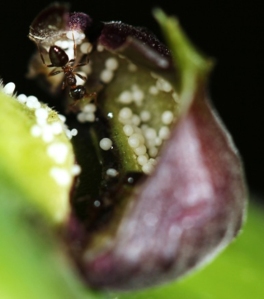 Response of ant-plant interactions to habitat degradation
Response of ant-plant interactions to habitat degradation
Pioneer plants are one of the component for effective forest regeneration. In SE Asia, species of tree in the pioneer genus, Macaranga provide ants of the genus Crematogaster with living space inside hollow stems, and food through secretions of sugars and food bodies. In return the ants give protection against herbivory activities. These myrmecophytic (ant-inhabited) trees rapidly die if no ants are present, and the ants that live in the trees do not live elsewhere. For this project our research has three objectives: I. To determine how the Crematogaster-Macaranga interaction network changes with habitat degradation. II. To assess whether the persistence of protection of plants by ants is robust to habitat degradation. III. To assess whether the provision of food and living space by plants to ants in return for protection is affected by habitat degradation.
Publications
Fayle T.M., Wanji, C, Turner E.C. & Yusah K.M. (2017) Living together in novel habitats: A review of land-use change impacts on mutualistic ant-plant symbioses in tropical forests. Chapter 3, pp 52-72. In Ant-Plant Interactions: Impacts of Humans on Terrestrial Ecosystems. Ed. Oliveira, P.S. & Koptur S. Cambridge University Press [PDF]
Fayle T.M., Edwards D.P., Foster W.A., Yusah K.M. & Turner E.C. (2015) An ant-plant by-product mutualism is robust to logging of rain forest and conversion to oil palm plantation. Oecologia 178: 441–450 [PDF]
How does vertical stratification of ant communities change in response to habitat degradation and fragmentation?
 A huge percentage of Southeast Asian rainforests has been degraded and fragmented as a result of human activity. Deforestation by logging and agricultural development is the biggest threat, and natural habitats are being destroyed at an alarming rate. Although leaf-litter ant communities are relatively robust to logging, it is expected that canopy communities will be more affected, since the removal of trees directly affects their habitat. The aim of the research is to look at how the loss of canopies in fragmented forest affect canopy ants in terms of their community composition and structure. Moreover, data collected will be one of the baseline pre-fragmentation dataset for ants from the canopy of the studied areas.
A huge percentage of Southeast Asian rainforests has been degraded and fragmented as a result of human activity. Deforestation by logging and agricultural development is the biggest threat, and natural habitats are being destroyed at an alarming rate. Although leaf-litter ant communities are relatively robust to logging, it is expected that canopy communities will be more affected, since the removal of trees directly affects their habitat. The aim of the research is to look at how the loss of canopies in fragmented forest affect canopy ants in terms of their community composition and structure. Moreover, data collected will be one of the baseline pre-fragmentation dataset for ants from the canopy of the studied areas.
Publications
Yusah K.M., Foster W.A., Reynolds G. & Fayle T.M. (2018) Ant mosaics in Bornean rain forest high canopy depend on spatial scale, time of day, and sampling method. PeerJ 6:e4231 [PDF]
Yusah, K. M., Fayle, T. M., Harris, G. and Foster, W. A. (2012) Optimizing Diversity Assessment Protocols for High Canopy Ants in Tropical Rain Forest. Biotropica 44: 73-81. [PDF]
Foster, W. A., Snaddon, J. L., Turner, E. C., Fayle, T. M., Cockerill, T. D., Ellwood, M. D. F., Broad, G. R., Chung, A. Y. C., Eggleton, P., Khen, C. V. and Yusah, K. M. (2011) Establishing the evidence base for maintaining biodiversity and ecosystem function in the oil palm landscapes of South East Asia. Philosophical Transactions of the Royal Society B-Biological Sciences 366: 3277-3291. [PDF]
 Altitudinal gradients of ant diversity and ant-mediated scavenging rates
Altitudinal gradients of ant diversity and ant-mediated scavenging rates
Responses of animal and plant communities to altitudinal gradients are of interest, since these allow tentative predictions to be made in terms of future impacts of climate change. In this project we are investigating how ant communities change along an altitudinal gradient on Mt Kinabalu (200m-3700m). We are also assessing, in parallel, the rates of ant-mediated scavenging activity. We predict that decreases in ant abundance and activity at higher elevations will lead to reductions in ant scavenging rates.
Publications
Yusah, K. M., Turner, E. C., Yahya, B. E. & Fayle, T. M. (2012) An elevational gradient in litter-dwelling ant communities in Imbak Canyon, Sabah, Malaysia. Journal of Tropical Biology and Conservation 9: 192-199. [PDF]
